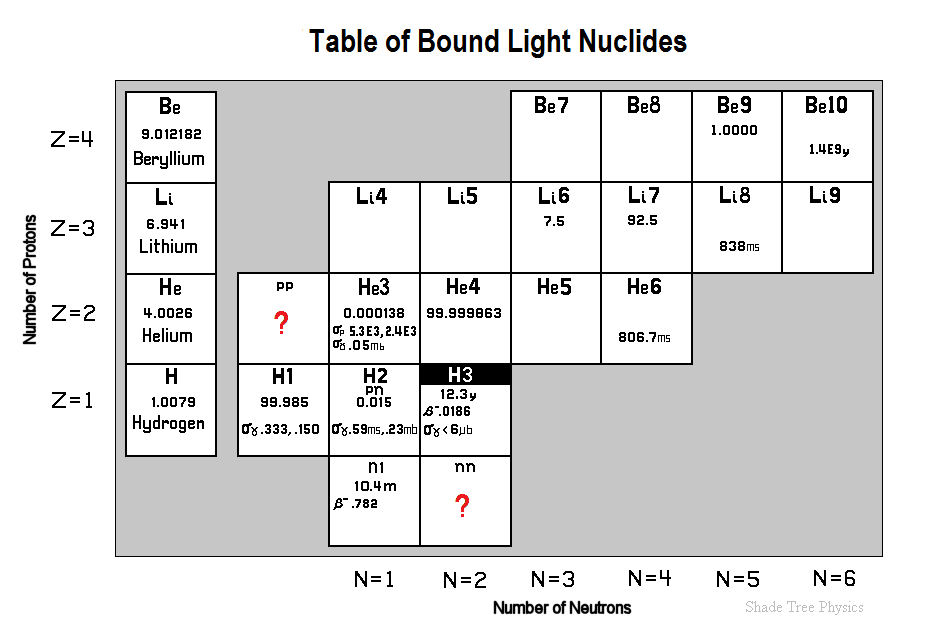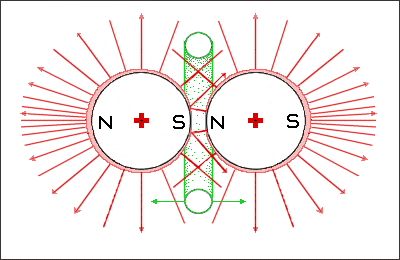This article is in four sections.
Emisson-Absorption-Scattering (EAS) Sub-Quantum Physics
EAS Nuclear Glue
EAS Neutron Beta Decay
EAS Mass Excess
The EAS Nuclear GlueInstalled sometime prior to 13 Feb 2000 - Latest Update 24 Sep 2018*.
Changes and/or additions are in bold.

Table updated 22 Sep 2018.
Introduction
In its realm of activity the nuclear strong interaction is generally held to be more than a hundred times stronger than the Coulomb interaction. Because of that we usually consider that there is an equivalence of proton-neutron pn, proton-proton pp and neuton-neutron nn forces. But we have NO stable pp or nn pairs in captivity. (See the diagram above.) Something may be fundamentally wrong with the standard model! In 1955, Evans(1) explained the problem by saying that, for these unstable pairs, the scattering length is negative. [Emphasis added.]
The following two paragraphs are from Wikipedia Isotopes of Helium [Incorporated on 06 Feb 2016. Emphasis added.]
"Although there are nine known isotopes of helium (He) (relative atomic mass: 4.002602(2)),
only helium-3 (3He) and helium-4 (4He) are stable. All radioisotopes
are short-lived, the longest-lived being 6He with a half-life of 806.7 milliseconds. The
least stable is 5He, with a half-life of 7.6×10−22 s, although it is possible
that 2He has an even shorter half-life.
. . .
Helium-2 or 2He, also known as a diproton, is an extremely unstable isotope of helium that
consists of two protons without any neutrons. According to theoretical calculations it
would have been much more stable (although still beta decaying to deuterium) had the strong
force been 2% greater.(2) Its instability is due to spin/spin interactions in the nuclear
force, and the Pauli exclusion principle, which forces the two protons to have anti-aligned
spins and gives the diproton a negative binding energy.(3)"
I claim that the absence of bound di-protons (pp) and di-neutrons (nn) (shown by question marks in the nuclide table, above) calls for ideas about the nuclear strong interaction to be replaced by a construct that is consistent with experimental evidence.
Applying the EAS Model to the Problem
If we treat protons as co-rotating rings of charge (radius 1.2 exp-15 meters, with smeared charge tangential speeds being approximately one half the speed of light) and with the rings separated by the same inter-nuclear distance, we arrive at a ball park figure for the pp magnetic forces on the order of 10 Newtons. With the magnetic fields aligned so as to produce minimum repulsion we could thus reduce the repulsion by one fourth. That's a sizable chunk of the action. Then, if the Coulomb interactions between the protons were to be so kind as to depart from spherical symmetry (in a manner that further decreases the up-close pp repulsion) we might be able to entertain some classical ideas about how the nuclear glue works. We do not, in fact, know whether the Coulomb inverse square relation holds true in nuclear confines. A lot of theoretical work in nuclear physics still hinges on that unproved assumption.
In Emission-Absorption-Scattering (EAS) Sub-quantum Physics the emission patterns of what Hawking calls force carrying particles for protons and electrons, (positive chargelets and negative chargelets in this model) may depart from spherical symmetry. This implies that the inverse square Coulomb relation between nucleons in a given atom will not be strictly applicable and that repulsive forces can be less than expected.
The EAS hypothesis also posits that charged particles (protons in this discussion) shield one another from positive and negative chargelets arriving from the gaseous ether of force carrying particles. (This gaseous ether is akin to Dudley's neutrino sea but is considered to be on a more finely divided, less catastrophic, scale.) This mutual shielding of nucleons from the inbound EAS particles would provide an additional contributing factor in the reduction in the mutual repulsion of nucleons.
In this model the positive chargelet fluxes emitted by protons can perturb (or produce a redistribution in) the emission patterns of other close-by protons, and vice versa. What is envisioned here is more or less spherical protons with negative chargelet absorbing - positive chargelet emitting surfaces. These surfaces can be impelled to migrate away from environmental perturbations, i.e., the strong local bombardments of positive chargelets emitted by one or more other close-by protons.
The following graphic shows a migration of emitting surfaces for protons in a deuterium nucleus. The electron orbital (green) corresponds to the bedspring/slinky (or sleeve) pattern discussed in the section on Neutron Beta Decay. [Added 4 September 2005.]

Deuteron with "Slinky" Nuclear Electron Orbital
The induced migrations produce two effects, both of which make a partial contribution to what we call the nuclear strong interaction.
Firstly, tangential migrations of the emitting surfaces, away from the point of contact (or almost contact) result in less intense interior proton-on-proton positron flux bombardments. This reduces the pp repulsion from what the inverse square Coulomb relation would predict. [Paragraph modified on 4 September 2005.]
Secondly, the intensified outboard emissions of each nucleon produces an action-reaction inward thrusting effect which further cancels a large fraction, if not all, of the mutual repulsion of the protons.
Add in the coupling of the proton magnetic moments (up close this will be consequential), and we could get a loosely bound, very short-lived, pp pair. (So short-lived that they don't appear in atomic nuclide charts.)
I have to use nuclear electrons to get stable nuclei. Their magnetic moments, interacting with those of the protons, and their so-called "attraction" to the protons completes the glue job.
My apologies, here, about the energy crisis that many people think will occur if we think about constraining an electron to a nuclear volume. That is a realm in which we aren't actually measuring, or even trying to measure, the velocity of an electron. I naively claim that Heisenberg's uncertainty principle doesn't apply to non-measured phenomeona. Sorry to say that apparently it does. [Added 12 September 2005.]
References
(1) Evans, R. D., The Atomic Nucleus, McGraw-Hill, New York,
p. 343-344. (1955)
Evans cites Cohen, B. L. and Handley, T. H.,
Phys. Rev., 92, 101 (1953).
(2) Bradford, R.A.W., The Effect of Hypothetical Diproton Stability on the Universe Astrophys. Astr., 30, 119–131 (2009)
(3) Bertulani, C.A., Nuclear Physics in a Nutshell, Princeton University Press, Princeton, N.J., Chapter 1, ISBN 978-0-691-12505-3 (2007)
Related Articles
Physicists discover new kind of radioactivity - PhysicsWeb, 24 October 2000. "The results [of an experiment at Oakridge] appear to give the first indication that the di-proton [possibly] exists within the nucleus." The experiment was not sensitive enough to determine whether the observed two-proton emission consisted of di-protons or separate (democratic) protons emitted simultaneously.